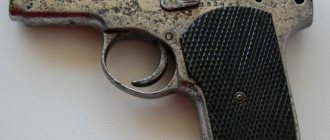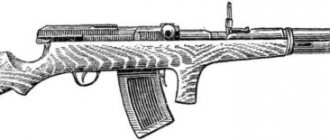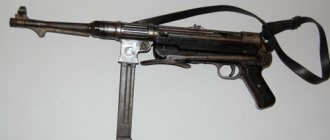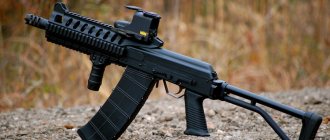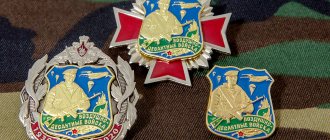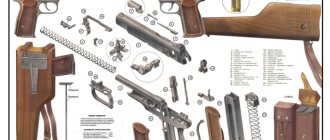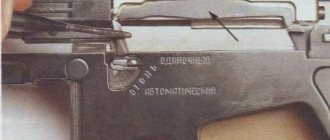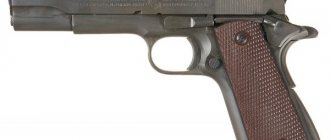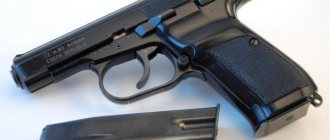The exact date of creation of a firearm called a pistol is unknown. Place of creation too. If you believe modern researchers, the word “pistol” has French roots, and according to other sources, it has Slavic roots. “Pishchal” is nothing more than a pipe. It was metal tubes that were used to make the first small arms.
Danila climbed with a backpack into the attic of an abandoned house in Manhattan. There was desolation all around, which is so necessary today. He pulled out a piece of wood he had picked up on the street, a coil of wire and a copper pipe. Using a knife, I made a primitive stock, fitted the tube and tied it tightly with wire. He clamped the back end tightly, making a small hole in it. Then he filled the tube with a mixture of saltpeter, manganese and sulfur, and sprinkled scraps of nails on top. The "pistol" was ready!
Many people remember the scene from the movie “Brother-2,” but not everyone knows that the first real pistol had a similar origin story.
Things from days gone by
Miniature copies of muskets became widespread in the 15th century AD. According to available information, the trendsetters were Italians (from the city of Pistoia, which is an additional argument), but this is only one of the versions.
Most likely, they simply put production on stream. But, in any case, soon the brilliant French nobles began to actively shoot their rivals in the boudoir of Parisian beauties.
D'Artagnan's ancestors borrowed this innovation from German mercenaries captured by the troops of Henry II in the battle with Italian troops at Ranti in 1554.
At that time, the weapon was equipped with a wick fuse (or lock), and although it was more comfortable to carry, it did not load much faster.
https://www.youtube.com/watch?v=pV0CalRL-Z4&t=13s
Most often, pistols were used by cavalrymen; holsters with loaded pistols were hung from the saddle.
Next step
In the 16th century, the inconvenient and dangerous wick was replaced by a wheel mechanism (according to legend, Leonardo Da Vinci himself had a hand in creating such mechanisms). The structure was started using a key.
This made it possible to avoid misfires, but complicated the loading process. Despite the simplification of the design over time, wheel locks remained extremely complex and expensive to manufacture, therefore, despite their reliability, they gradually gave way to other methods of ignition.
It is worth noting that some of the pistols already at that time acquired the semblance of unitary cartridges; it was not the pistols themselves that were charged, but separately inserted charging chambers; to reload such a pistol, you only had to change the chamber and cock the mechanism with a key.
In the 17th century, the wheeled mechanism was replaced by a flintlock mechanism, the essence of which was the hammer hitting the flint in the lock.
The carved spark ignited the gunpowder fuse in the breech (to be fair, such a mechanism was originally tested on guns). The pistols were, naturally, smoothbore. Although there were also rifled ones, in this case they were made by masters, and therefore extremely rare.
Already at the beginning of the 19th century, a capsule, a cap with a flammable composition, appeared. In view of this, the flintlock mechanism left the scene, since ignition using a primer was more convenient and faster. Initially smooth-bore, with the development of industry, pistols also received rifled barrels, which made it possible to improve the accuracy of the battle and increase the effective firing range.
Since the mid-twentieth century, weapons - pistols and revolvers - have taken another step towards increasing the rate of fire and multiple charges.
Heckler & Koch VP70
The VP70 is the semi-automatic predecessor of the Glock. This is the 1st production pistol with a plastic frame. Shoots only by self-cocking, there is no safety.
A unique feature of this weapon is that when combined with a holster-butt, you can switch the fire to another mode. When firing at three bullet clips, the VP70 will fire loads at 2,200 rpm. When detached, the butt acts as a holster.
The civilian modification does not have this feature, so it only fires single shots. VP70 was not widely distributed, but other developers actively used the experience of its creators.
Pistols and revolvers
The desire for speed of fire led to the creation of the revolver. The first samples were created back in the 16th century. The essence of the invention was the use of a rotating (translation of the word revolver) drum with charges.
But, in the presence of a flintlock, it was cumbersome and had the same problem with the constant addition of gunpowder to a special shelf to ignite the main charge and did not provide continuous firing.
The time of revolvers came in the 19th century.
At the beginning of the century, officer Artemas Wheeler from the United States officially documents the invention of a pistol with a cylinder and a percussion flintlock. A little later, the Englishman Collier presented an improved model in London.
The presence of a powerful spring in the form of a plate (a prototype of a mainspring) pushed the drum tightly and prevented breakthroughs of powder gases. A gun with a similar reloading mechanism was also presented.
This weapon was interesting, but too expensive and did not become widespread in Europe.
However, the design features were taken into account by gun specialists.
With the invention of the capsule, which ensures relatively continuous firing and machine-tool production of weapon components, which significantly simplifies and reduces the cost of work.
In 1836, a certain Mr. Pearson sold the invention of a pistol with a revolving mechanism for feeding cartridges to Colonel S. Colt in the same USA. Samuel established the mass production of capsule revolvers, known today as the Colt “Peacemaker,” and will forever remain in the memory of grateful humanity.
Soon American revolvers replaced similar single-shot types of weapons throughout the world. In the modern United States, there is a proverb about this: “God created people as they are, and only Colonel Colt made them equal.”
Beretta 93R
Initially, the Beretta 92 could fire bursts only after manual modification of the sear. The new Beretta 93R firearm does not have this drawback. It fires bursts with a cutoff, each containing 3 rounds. The rate of fire is approximately 1,100 rounds/min.
A compensator brake was added to the extended barrel. This led to improved shooting accuracy. To ensure stability of the weapon when firing, the design is equipped with a folding handle. It is located in front, near the trigger guard. Can be supplemented with a shoulder rest.
The Beretta 93R was discontinued because submachine guns with similar performance were more affordable.
Self-loading competitors
The hegemony of revolvers was interrupted by the invention of a semi-automatic type of reloading. In a weapon using innovation, the cartridge was fed from a box magazine into the breech through the use of powder gases, rather than the physical rotation of the drum.
The first sample appeared in 1892 in Austria-Hungary, manufactured by the Steyer arms factory. Subsequently it entered service with the cavalry units of the Austro-Hungarian army.
Subsequently, self-loading pistols took their perhaps main place in the history of small arms. And now about the differences in designs.
Machine guns
An extremely successful design decision of Mikhail Timofeevich was the creation of a machine gun for 7.62 mm caliber (PK). Working in emergency mode since 1958, Kalashnikov won the competition. In 1961, the USSR government gave preference to the PC rather than the Tula machine gun designed by Grigory Nikitin and Yuri Sokolov.
The Kalashnikov machine gun is still produced in different versions. The PC was used in the Vietnam War, the Cambodian civil conflict, the Afghan campaign, the Iran-Iraq War, the Gulf War, the Yugoslav conflict, and two Chechen campaigns.
The PC was the so-called single machine gun. In various variations, it was used not only in infantry units, but also installed on tanks and armored vehicles. On its basis, the modern Pecheneg machine gun, the Chinese Type 80 and the Serbian Zastava M84 were developed.
Perhaps the most unusual Kalashnikov model was the curved-barreled machine gun (KPK), which was created in the 1960s to hit the “dead zone” near the tank, inaccessible to straight-barreled weapons. In particular, the weapon was intended for the crews of damaged and damaged tanks.
The exotic barrel design (curvature of about 90 degrees) of the PDA made it possible to shoot from around the corner. However, the tankers greeted this idea coolly. The development of all types of curved-barreled machine guns was stopped.
Similarities and differences
Both types of weapons have a frame with a barrel, but unlike a revolver, a self-loading pistol may have an unsecured (free) barrel. The frame has a built-in housing with a trigger mechanism. Revolvers do not have a bolt with a spring and other components (ejector, bolt, etc.). Accordingly, an absolutely excellent cartridge feeding mechanism.
For revolvers, cartridges are located in chambers (special compartments) of the drum, and for self-loading (automatic) pistols, in magazines. The location of the magazine can be different, both in the handle and in a separate part of the weapon. The supply of ammunition is carried out by powder gases.
Laumann pistol. How an accidental shot led to the discovery of automation
In general, the lever reloading scheme in relation to the pistol turned out to be so-so, nevertheless, designers experimented with it on both sides of the Atlantic. One of these experimenters was the Austro-Hungarian gunsmith Joseph Laumann, who created his own version of a lever pistol, but not with a tubular, but with a box magazine for five rounds, which was placed like a rifle - in front of the trigger guard. The longitudinally sliding bolt of the pistol also resembled a rifle. The whole design was so far from perfect that it once fired in the hands of the inventor with the bolt not fully closed. However, nothing terrible happened, the spent cartridge simply threw the bolt back, hit the reflector and flew out. Perhaps a random shot is only a legend. However, if you believe her, then it was this incident that gave Lauman the idea of converting a lever pistol into an automatic one. All that remained was to remove the unnecessary bracket, install the return spring and calculate the force of the spring and the mass of the bolt so that the recoil occurred after the bullet left the barrel. This is how the first pistol with a (conditionally) blowback bolt was invented - such a scheme with serious modifications was later patented by John Browning.
Why successful pistol designs could turn out to be dead ends
The Laumann pistol was loaded using a metal pack, like the Austrian Mannlicher rifle. To discharge, you had to press a metal button, and the pack would fly up, while the empty pack itself would fall down through a special window. The bolt was cocked by a massive lever on the right side. The total length of the pistol was 228 mm, the barrel length was 142 mm, and the weight was more than 1 kg.
The world's first automatic pistol went into production under the name Schönberger M1892 (Schönberger model 1892, apparently after the name of the manufacturer). The caliber of the pistol was 7.8 mm, but not a single cartridge has survived to this day, not even the characteristics of the ammunition have been preserved. Only a few dozen Schönberger M1892s were produced. In 1896, these pistols were tested by the Austrian military, but were rejected.
Cartridge
Revolving cartridges are distinguished by the presence of a rim, and, as a rule, by increased power, since placement in the chambers of a drum, without the presence of moving parts, limits the strength of the designer less. But now these lines are blurring, revolvers can be designed for a pistol cartridge, but in this case the cylinder requires more complexity to securely fix the cartridge in the chamber.
Pistol cartridges may differ in design, such as a hidden flange or a semi-protruding one, the fact is that flangeless cartridges are more suitable for use in box magazines. But at the same time, unlike revolver cartridges, the power of a pistol cartridge cannot be increased unnecessarily; this will lead to rapid wear of the rubbing parts of the pistol.
The most famous pistol cartridges are used - the iconic US pistol - Colt M1911, 11.43 mm cartridge, M9 pistol, 9 mm Para Luger cartridge, 9x18 mm PM cartridge.
Details
The biggest difference is the cartridge feeding mechanism. Revolvers are equipped with drums containing compartments for ammunition - chambers (it is not for nothing that the word revolver comes from the Latin revolvere - to rotate). On the first samples, the drum was driven manually (there are models of multi-barrel revolvers, where each chamber is a separate barrel).
With the invention of the leaf spring, rotation was ensured by it when transmitting muscular force when pressing the trigger. The installation of the drum can be either fixed, on an axis in the frame, in this case, a device called an Abadi door is used for reloading, or the fracture structure of the frame itself, in this case, reloading is carried out when the body of the weapon is broken.
The drum can also be tilted to the side, or even removed from the frame. A trigger revolver can be either double or single action. In the first case, the shot is fired only by pressing the trigger; single-action revolvers require preliminary cocking of the hammer. This mechanism was used in the Colt “Peacemaker”, for example, or in the soldier’s Nagan mod. 1898.
Semi-automatic and automatic pistols use the energy of powder gases and recoil to reload.
The pistol is fed with ammunition from a magazine, which can be of any design; they are united only by the method of feeding the cartridge, one at a time and alternately.
Pistols, unlike revolvers, have a wide range of varieties and types. Mainly related to store placement and design:
- Box-shaped, integral - Mauser C96 or Steyr 1912;
- Box-shaped, detachable in the handle - classic - Browning, Colt M1911, TT;
- Disk, increased volume – Borchard-Luger R.08;
At the same time, there are also extremely interesting weapons, for example the Mannlicher pistol mod. 1884, which has a single action trigger.
Glock 18
The Glock 18 is a modified version of the Glock 17. It is an automatic pistol developed for the special anti-terrorist unit of Austria. It was intended to be used by police and military forces. It could not compare in efficiency with submachine guns, so it did not gain popularity.
Structurally reminiscent of its predecessor. However, the Glock 18 is equipped with a rate-of-fire switch. This allows you to quickly switch the mode from single shots to burst release. In the latter case, the weapon will fire at a speed of 1,200 rds/min.
Glock GmbH produces models that switch to firing in bursts of 3 shots. Another option is pistols that switch to full-automatic mode. The manufacturer does not produce guns like the Glock 18, which combine both of these capabilities.
Classics of the genre
The description and characteristics of various types of pistols and revolvers deserve not just an article, but a multi-volume publication. Let's look at the most famous and well-known ones. The hit parade of famous models opens:
Lepages are French flintlock pistols designed by Jean Le Page, produced in sets. Due to the all-Russian fame of the novel by A.S. Pushkin "Eugene Onegin". The poet’s fatal duel, interestingly, took place on Karl Ulrich’s percussion pistols.
Colt is a surname that has become a common noun for most revolvers. American pistols are an integral attribute of police weapons in many countries; the most famous is a pistol designed by Browning, but produced by the Colt factory - M1911 .45 caliber.
Other famous US revolvers and pistols:
- Smith-Wesson arr. 1871 (an American revolver that was in service with the Russian army, which is why it received the designation “Russian”);
- Colt M1911 - it is this pistol (more precisely, its designer Joseph Moses Browning) that history owes to the main design features of self-loading pistols.
Nagan is a similar, but European story. Patented by the Belgian gunsmiths - the Nagan brothers, the revolver entered service with some armies, thanks to one interesting new product. Nagans solved the problem of the breakthrough of powder gases between the barrel and the cylinder of a revolver. Before firing, the drum moved towards the barrel, and the muzzle of the cartridge case entered its channel.
German pistols are a whole galaxy in the small arms universe. The first number was the Mauser S-96, mentioned above. But the most popular were the German pistols of the Second World War of the Walter and Luger brands. Of course, these are also the names of the designers.
But what’s interesting is that the Prabellum, which has become a symbol of the German army, is one of the Luger models. The modification for artillery units with a long barrel looks especially impressive.
Walter is better known as a James Bond weapon (PPK model), but in the modern world it is in demand both in the army and police forces.
You can also talk for a long time about USSR pistols. The first example of combat pistols from the Country of the Soviets was the famous TT (a project by designer F.V. Tokarev), created in 1929 in order to replace models of foreign weapons.
Other classic models are the Makarov pistol (PM) and the Stechkin automatic pistol (APS), which are in service with the army and law enforcement units.
Currently, a number of bright and talented designers have emerged - Yarygin with his PYa ("Rook"), for example, in addition, pistols created by teams of authors have appeared - GSh-18 and others.
Weaponry schools in Switzerland, Austria and Italy are also known. Beretta, ZiG and Glock pistols occupy the top ranking of modern weapons.
Revolvers have given way to pistols in the military, but they are still widespread in the civilian market and among the police. Moreover, the French special forces use revolvers as additional weapons, this is due to their high power and the fact that in the event of a misfire, the revolver does not require manipulation by jerking the bolt.
Our days
Among the variety of modern types of hand-held small arms, two categories already discussed should be distinguished, but within their framework there are samples that differ in purpose, caliber, methods of shooting and aiming. Trends in the development of this type of small arms are mainly related to the requirements of army special forces, police and, in a number of countries, private use.
The main areas of development are reducing recoil when fired, ease of use, rate of fire, concealed wearing, the use of composite materials and alloys to reduce the weight of weapons, multi-charging, and full automatic firing. While maintaining design features, pistols become more compact and lighter.
In addition to combat ones, varieties of sporting and hunting pistols and revolvers appeared.
Specifications
The performance characteristics of the APS pistol are presented in the table:
| Caliber APS | 9mm |
| Weight without ammunition and holster | 1,002 g |
| Weight with ammunition and holster | 1,780 g |
| Rate of fire | 40/90 rounds per minute |
| Ammunition capacity | 20 rounds |
| Bullet speed at departure | 340m/s |
| Precision shooting | 200 m |
| Length | 225 mm |
| Height | 150 mm |
As can be seen from the given technical characteristics, the developer coped with the task and created a pistol capable of conducting aimed fire at a target located at a distance of 200 m.
Lethal bullet range up to 350 m.

